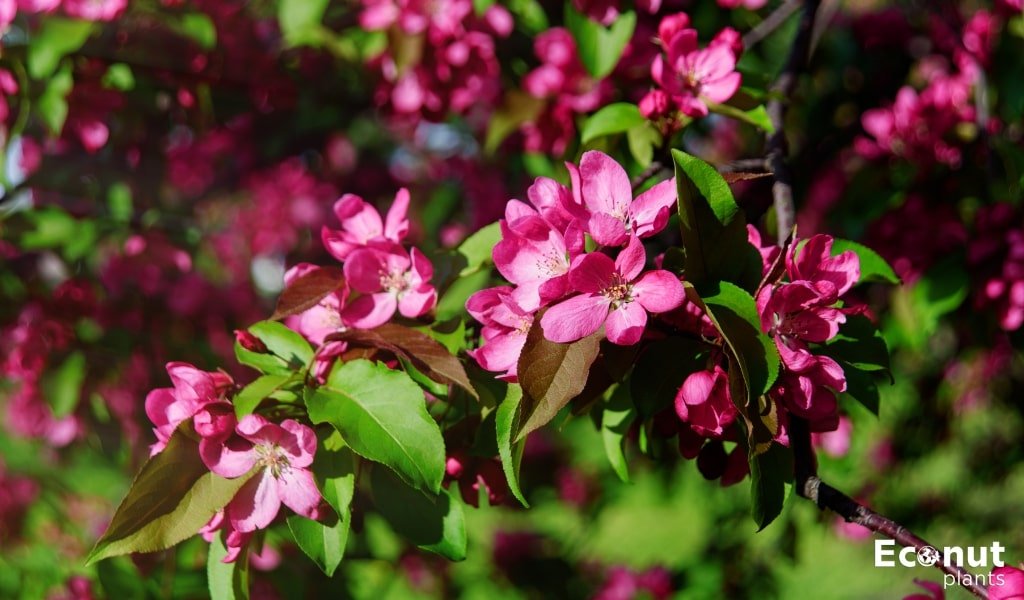Pink flowering trees bring colour to any yard during the growing season and have bright, cheery blooms. Whichever size tree you choose for your landscaping, these pink blossoms add a stunning and energizing flash of colour. Trees range in size from small shrubs to reasonably tall trees.
Are you looking for some trees in your yard or anywhere in your garden that will bear pink blooms to plant? Pink-flowering trees may contribute a little more symmetry to a thoughtfully designed garden area. We examine our top picks for pink-flowered trees in this post, complete with descriptions and images!
1. Gala Apple Tree
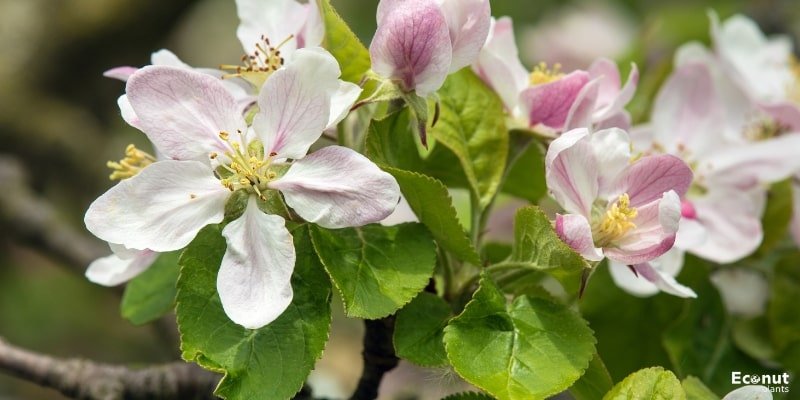
Scientific name: Malus domestica gala
This type of apple tree is indigenous to New Zealand and bears delicate pink and white flowers. The fruit of the blooms is the gala apple, a delicious and well-liked species of apple tree that works well for manufacturing apple juice.
In general, this tree blooms from April to mid-May, although it also depends on the winter conditions and whether the tree has had the necessary number of cool hours during its winter hibernation. When a flower opens, its petals reveal a beautiful blend of pink and white.
Typically, the blossoms have an outer pink shell. In USDA Zones 5 through 8, this tree grows well. For them to bloom and bear fruit, full sun is necessary.
2. Kanzan Cherry Tree
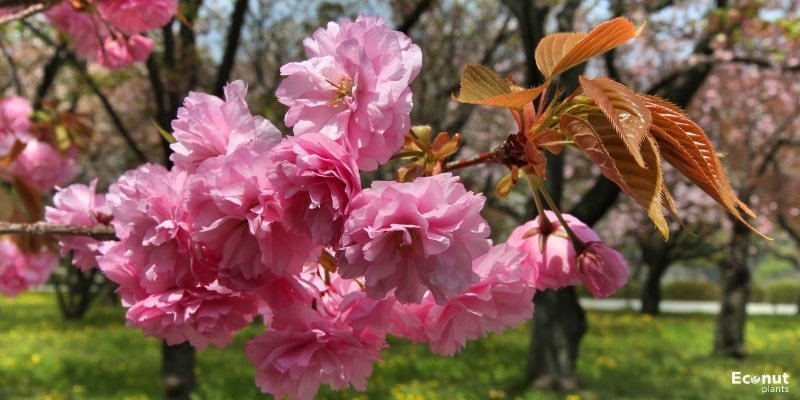
Scientific name: Prunus serrulata ‘kanza’
This is probably the variety that comes to mind when you think of “cherry tree.” Every spring, this well-liked species blooms an abundance of medium-to-dark pink flowers in a vase-like structure. In Zones 5 through 9, the blossoms, which have a diameter of about 2.5 inches, are visible in April and May.
Growing in a range of soil conditions, the Kanzan cherry is a full-sun variety. When fully grown, it can reach heights of approximately 40 feet. But it only has a 25-year lifespan. Stressors like pollution and heat can also greatly affect it.
3. Pink Trumpet Tree

Scientific name: Handroanthus heptaphyllus, H. impetiginosus
Pink trumpet trees produce thousands of trumpet-shaped pink flowers on leafless branches when they bloom. As a consequence, viewers are left with a breathtaking pink blossoming tree that leaves a lasting impact. Being an early bloomer, they usually start to blossom in March or April.
Because it is a native of South America, this tree is deciduous and loves full sun and low water. Although it can grow in sand, clay, alkaline, or acidic soils, it always needs well-drained soil to be healthy. Because of its non-invasive roots, this ornamental tree is preferred for residential locations.
4. Redbud
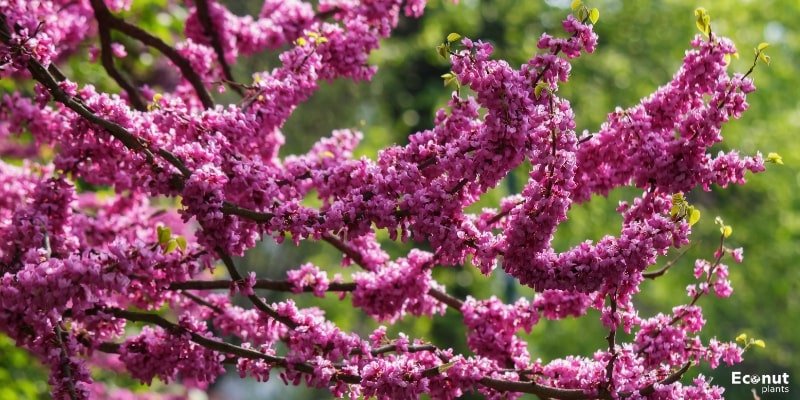
Scientific name: Cercis Canadensis
Small and delicate, redbud trees are among the first to bloom in the spring. They are resilient plants with stunning flowers in delicate pink hues, despite their very small stature. For a few weeks only, they blossom. But all year round, their heart-shaped, scarlet leaves make for a pleasing sight.
The California redbud, the western redbud, and the eastern redbud are the three types of redbuds. All varieties of the blooms are edible, and for ages, healers have used the bark to treat various ailments. The tree attracts a variety of butterflies and honeybees, and chickadees and grosbeaks particularly enjoy the seeds it yields.
Planting this tree won’t be tough if you reside in Zones 4 through 9. It needs four hours or more of direct sunlight per day and can grow up to thirty feet tall. It also performs well in a range of soil conditions.
5. Smoke Tree
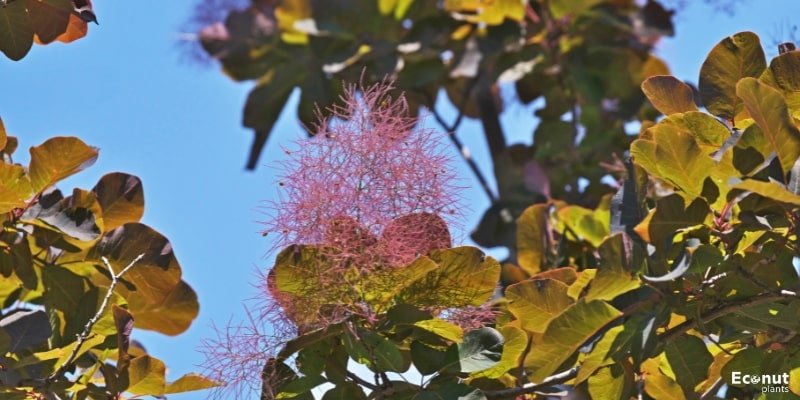
Scientific name: Cotinus coggygria
The smoke tree’s flowers are a soft, smokey pink. They look like clouds, which fits perfectly with the “smoke” motif. The blooms usually stop blooming by September after peaking in late summer and early autumn. For an ornamental tree, it’s a visually appealing sight.
The smoke tree doesn’t care what kind of soil it grows in; however, it does favour well-drained soil. It is also a pretty low-maintenance plant because it can withstand periods of extreme moisture and drought. To reach its full fifteen feet in height, it prefers full sun, though. This plant, though it can grow into a tree, is thought of as a red-flowering bush.
6. Variegated Weigela
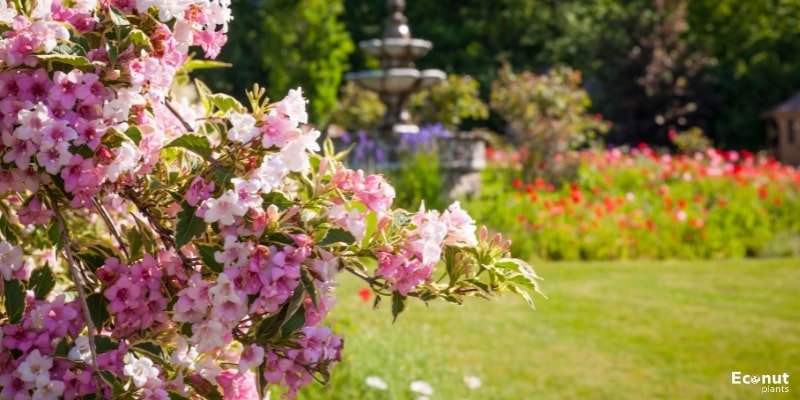
Scientific name: Weigela Florida variegata
This shrub yields some of the most exquisite blooms a gardener could wish to see every spring, with vivid pink, trumpet-shaped flowers. The entire plant is a sight to behold during the blooming season because of its branching structure and variegated foliage with white streaks.
Only Zones 5 through 9 are suitable for growing these resilient tiny plants, which enjoy full sun-to-light shade. These plants may grow up to four feet tall and five feet broad, and they thrive in almost any kind of soil.
7. Weeping Cherry Tree
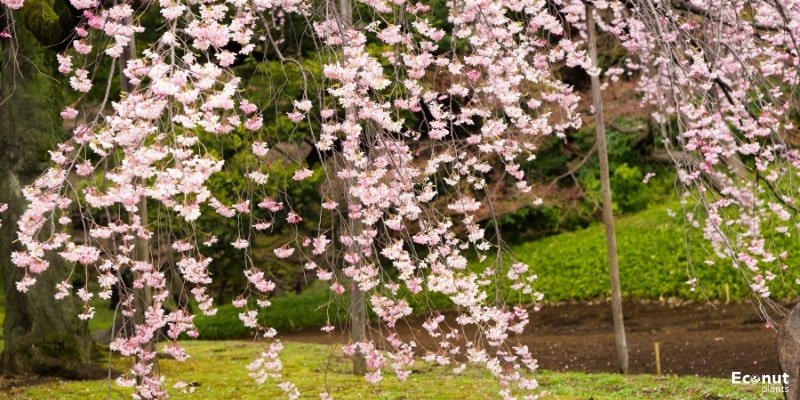
Scientific name: Prunus pendula
The weeping cherry tree is the most beautiful and romantic-looking pink blossoming tree in this book. Distinguished from a cherry flower or fruiting cherry tree, this striking tree is short and slender, with long branches that dangle to the ground. Every spring, the tree’s dark branches explode with single or double pink and white blossoms, generally before the leaves appear.
There are various varieties of weeping cherry trees. Zones 4 through 9 are where it is most frequently found, though. They prefer full sun and soil that is wet and well-drained.
8. Winesap Heirloom Apple Tree
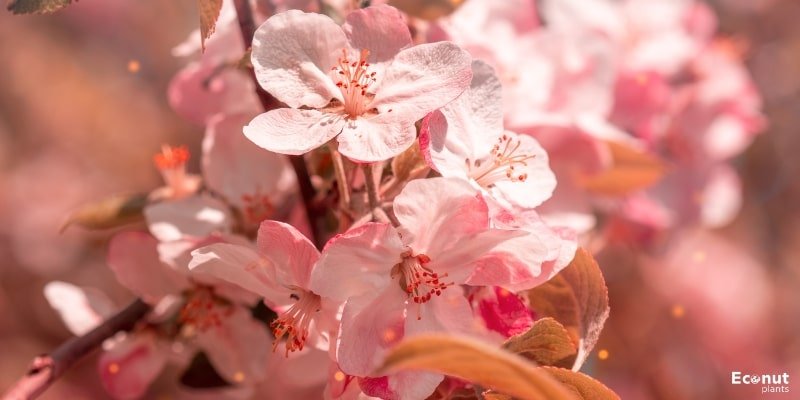
Scientific name: Malus Winesap
The Winesap heirloom apple tree is another type of apple tree that bears soft pink blooms. This tree, whose roots date back to the colonial era, produces crisp, tangy fruit that is ideal for baking.
Fascinatingly, unlike many other apple varieties, the wine grape variety of apple trees is incapable of self-pollination. To ensure that your Winesap apple tree bears fruit, you must plant a minimum of two additional tree varieties to aid in pollination.
9. Prairifire Flowering Crabapple
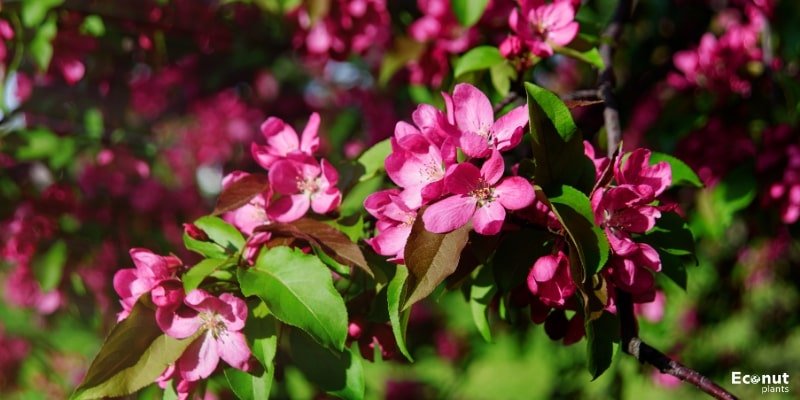
Scientific name: Malus prairie
While there are many varieties of flowering crabapples, we particularly like the Prairifire variety. The beautiful dark pink and crimson blossoms of this tree emerge from April to May. Additionally, they have striking foliage that changes colour with the seasons, from a deep maroon in the summer to a flaming bronze in the autumn.
This tree may be cultivated in a pretty wide range of climates because it can be grown in Zones 3 through 8. The flowering crabapple needs at least six hours of direct sunlight, but full sun is preferable for best growth. They can be cultivated in clay, sandy, moist, acidic, or alkaline soils; they have no affinity for any particular type of soil.
10. Pink Dogwood Tree
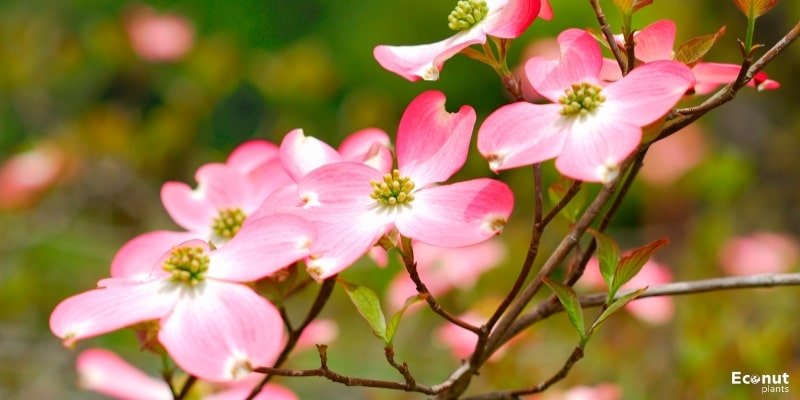
Scientific name: Cornus Florida var. rubr
There are several reasons why landscapers and gardeners love the pink dogwood tree. It is a sight to behold in full bloom, but it’s also an excellent plant to place next to buildings or beneath electricity lines.
The tree bears somewhat large pink flowers with white veins running through them towards the yellow-green center in April and May. For a different look, some dogwood tree species also have purple blossoms. Their dark green, egg-shaped leaves turn a vivid purplish-red in the autumn. The tree generally grows rounded.
11. Japanese Flowering Apricot
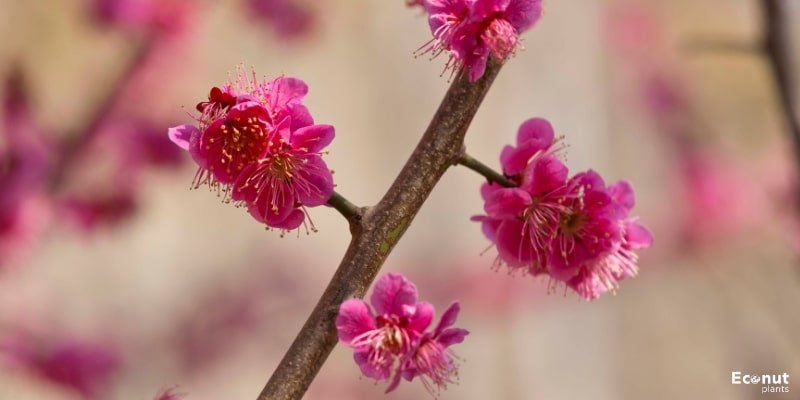
Scientific name: Prunus Mume
This gorgeous decorative tree bears tiny, five-petaled, pink and white blooms with a vibrant yellow center. Contrary to what their name might imply, people appreciate these trees for their blossoms and foliage rather than the fruit they yield. The blossoms are delicious and have a pungent perfume that many compare to cloves.
The Japanese flowering apricot tree has a broad canopy that stretches 15 to 20 feet, and it can reach a height of 20 feet. They thrive best in Zones 6 through 8 and are frequently seen in parks and parking lots.
12. Higan Cherry
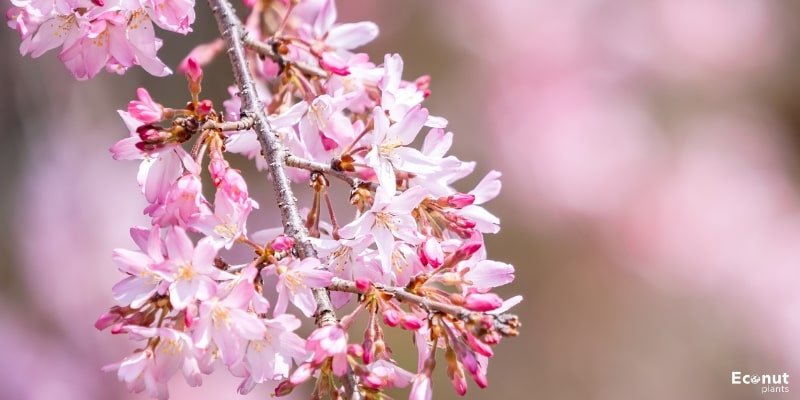
Scientific name: Prunus subhirtella var. autumnalis
One of the most beautiful and well-liked types of cherry trees are higan cherry tree. It is well-known for both its amazing pink and white blooms and its unusual blooming period. Although they usually bloom in the spring, these trees can also infrequently blossom in the autumn.
These trees have tiny, ten-petaled flowers that are less than an inch across. They go through several colour changes during their bloom period, changing from a dark pink bud to a pink-white one as they open. They also yield little blackberries.
Higan cherry ornamental trees thrive in moist, well-drained, acidic soil and are cold-hardy plants. It grows best in Zones 5 through 8, and it prefers full sun to partial shade.
13. Dwarf Poinciana Tree
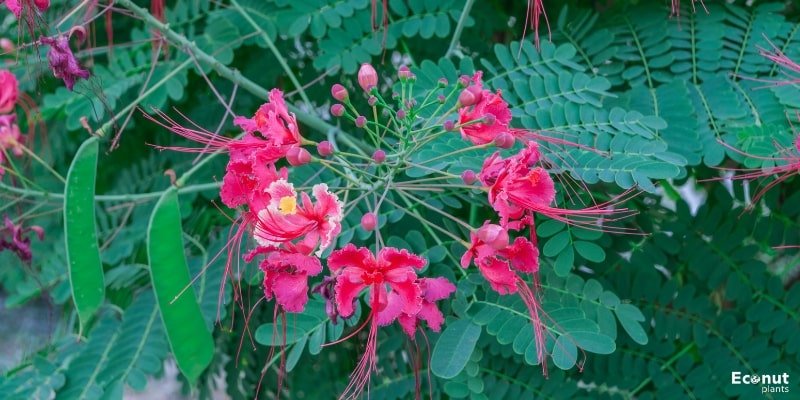
Scientific name: Caesalpinia pulcherrima
The national flower of Barbados, the dwarf Poinciana tree, is an ornamental accent tree that is usually found in tropical places such as southern Florida. Beautiful flowers in a variety of colours can be seen on this tiny dwarf-although there are types with dark pink blooms as well, the most common blossom colours are red or orange Blooming tree.
Although there are types with dark pink blooms as well, the most common blossom colours are red or orange. This tree can grow to a respectable height of 12 feet, depending on how it is pruned. It enjoys full light. It performs best in Zones 9b and 10 in the United States.
14. Crimson Bottlebrush
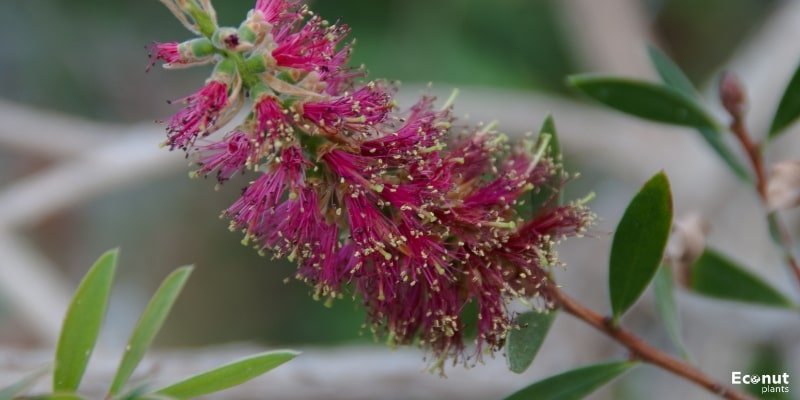
Scientific name: Callistemon citrines
Originating from Australia, a crimson bottlebrush is a tiny, dense bush. While most bottlebrushes are red, other varieties—like the Perth pink—bring lovely clusters of deeply pink flowers.
Each blossom measures approximately four inches in length and has a spiky look. While many other pollinators are drawn to them, hummingbirds are especially fond of them. The leaves and blooms themselves have a strong aromatic scent as well.
Generally speaking, crimson bottlebrushes are low-maintenance plants that reach up to eight feet in height. They don’t usually have insect issues or illnesses, and they grow best in full sun and acidic, well-drained soil. USDA Zones 10 and 11 are ideal for this plant’s performance.
15. Crape Myrtle
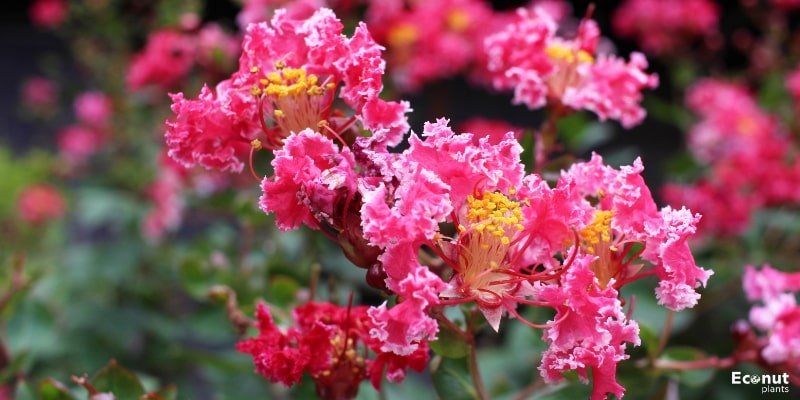
Scientific name: Lagerstroemia indica
Small deciduous trees with distinctively attractive grey and brown trunks, crape myrtle plants bloom a beautiful pink. Giving the tree its name, the pink petals have a crumpled texture similar to pancake paper. A lot of birds and bees will visit the tree throughout its late spring to early autumn bloom.
For the crape myrtle, hot, sunny areas are suitable, which includes Zones 6 through 9. Fast-growing, the trees can reach up to 25 feet in height and roughly 15 feet in spread. Despite doing well in both acidic and alkaline soils, they prefer small amounts of soil. The tree will flourish provided the soil is kept damp and well drained.
16. Desert-Willow
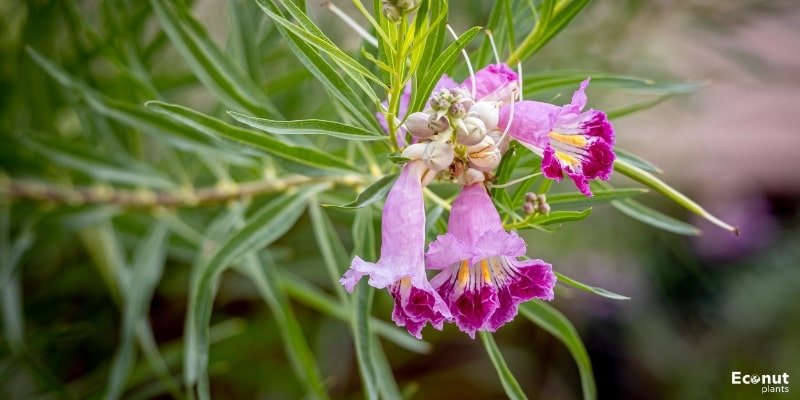
Scientific name: Chilopsis linearis
The desert willow is unrelated to the well-known willow tree, despite its name. But when it comes to the branches and leaves, it does look comparable. This tree’s gorgeous pink blossoms are where it shines. These fragrant, flamboyant flowers appear in the middle of summer. The tree will yield more blossoms the more it is pruned.
This tree, which may grow to a height of 25 feet, enjoys heat and full light. It does not have a preferred type of soil, although it grows best in Zones 7 through 9, and it should be well-drained.
17. Flowering Almond Tree
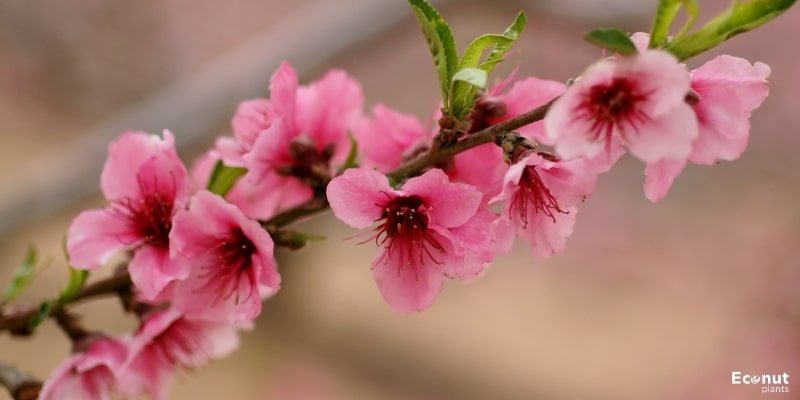
Scientific name: Prunus glandulosa
The deciduous, flowering almond tree is indigenous to China and Korea. At no more than five feet tall and four feet broad, it is quite modest in comparison to the other trees in this guide.
Each flower on this tree is approximately an inch in size and is a gorgeous blend of pink and white. Especially for the eastern tiger swallowtail, which uses the plant as a larval host, they are a great addition to a pollinator or butterfly garden. Having said that, neither dogs nor cats get along with these plants.
Almond trees that bloom can be found in Hardiness Zones 4 through 8. They are full-sun plants, although they also perform well in partial shade. These are also adaptable plants that can grow in a variety of soil types and are drought-tolerant.
18. Hong Kong Orchid Tree

Scientific name: Bauhinia blakeana
The round-topped Hong Kong orchid tree features a canopy of grey-green leaves. It produces huge, six-inch pink and purple blossoms over the summer and winter seasons. The flowers on this type of orchid tree are sterile and do not develop seed pods, in contrast to other varieties.
This plant is frequently seen in parks, parking lot islands, corporate gardens, and areas close to patios and decks. It is a sun- and heat-loving plant that is restricted to Zones 9b through 11. It is a drought-tolerant plant as a result. Although this tree is not a genuine orchid, it does have blossoms that are very similar to those of those of those magnificent plants.
19. Jane Magnolia
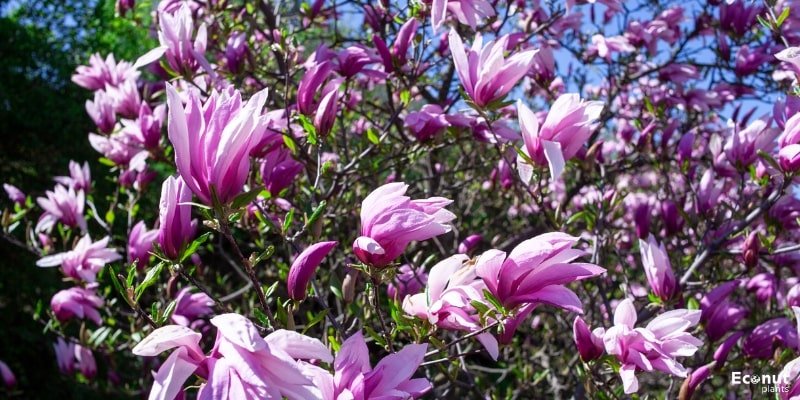
Scientific name: Magnolia liliflora ‘reglorescens’ x stellate ‘waterlily’
The American National Arboretum created the hybrid Jane magnolia tree in the 1950s. The tree bears enormous, white inside-and-out tulip-shaped flowers with dark pink skin. There’s also a subtle smell to the blooms. Late April is when the tree typically blossoms.
Zones 4 through 7 are home to this kind of magnolia. This tree has to be planted in soil that is both moist and well-drained for the best growth. Additionally, put it in a location that will allow it to enjoy partial shade during the hottest portions of the day and full sun in the morning.
20. Persian Silk Tree

Scientific name: Albizia julibrissin
The Persian silk tree is a beautiful deciduous tree with distinctive pink blossoms featuring long, silky strands. The tree resembles an umbrella, and when the spiky pink and white blossoms are scattered over its large canopy, it creates an incredible sight.
This tree is fairly drought-tolerant and is not particular about the kind of soil it grows in. It enjoys mild weather because it is native to Asia. In the US, Zones 6b to 11b are the best for growth.
21. Red Horse-Chestnut
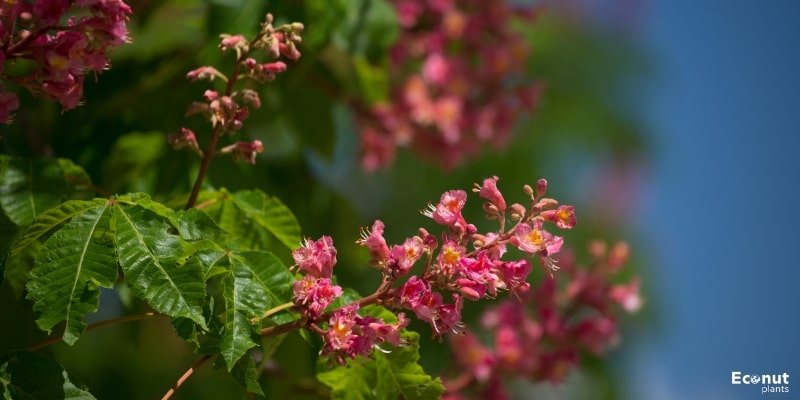
Scientific name: Aesculus x carnea
The red horse chestnut yields some of the most exquisite blossoms. This deciduous tree produces beautiful, hot-pink, eight-inch-long panicles filled with blooms every spring. Not only do the blooms have a gorgeous appearance, but butterflies and hummingbirds find them quite appealing. After the flowering season, it yields lengthy seed pods.
This tree is a great shade tree for parks because it can grow up to 40 feet tall and has a wide canopy. It can tolerate full sun or moderate shade, and it grows best in wet, well-drained soil. Zones 5 through 8 are ideal for it, making it an excellent choice for temperate areas like California.
Conclusion
Some of the most exquisite plants in nature are those with pink blossoms. Pink flowering trees come in a variety of types to fit your grow zone and maintenance needs, whether you’re going for delicate and romantic like the weeping cherry or big and spectacular like the Persian silk tree.
Why not plant a few in your backyard garden now that you have more knowledge about pink flowering trees and how to take care of them? If there is a pink flowering tree that you particularly like that we haven’t included on our list, please let us know.

